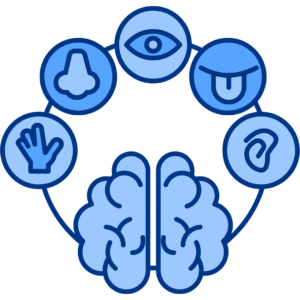What is Embodiment?
Seetha was experiencing a moment of embodiment, which is the “ability to feel a sense of connection between the mind and the body” (1). Embodiment also encompasses the experience of the body as it engages in the world, it is a person’s experience of living as a body (2). This includes the lived experience of the body and the physical body which shows up in the world.
Embodiment practices live within the umbrella of somatic psychology, which assumes that “events impact our physical, emotional, cognitive and spiritual being as a whole” and that “all events must be processed through our sensory systems” (3). In embodiment practices, the body is used as a tool for healing and allows for a relationship between our body, thoughts and actions. To better understand embodiment, it’s helpful to understand the different ways in which our bodies process sensory information.
As a way of coping, the experience of weight stigma predicts a vicious cycle of disordered eating symptoms, avoidance of physical activity and healthcare utilization. This tends to lead to difficulty managing weight and weight gain, resulting ultimately in more weight stigma by peers. Luckily, you can help as a parent.

In summary, the body takes in information through the five senses, through movement and through internal sensations. Embodiment practices aim to reconnect us to these various feedback systems, to integrate the body and the mind and to regulate the nervous system.
Interoception or interoceptive awareness, such as hunger and fullness, are of particular interest in the field of eating disorders (EDs), as there is a disruption of the awareness of these internal signals (4).
In the development of EDs, people become less and less aware of their internal sensations. There is a disconnection between felt sensations and a person’s ability to recognize them. A study has demonstrated that in those living with EDs, participants are less able to accurately perceive their heartbeat as compared to those living without an ED (5). This suggests that interoceptive awareness, the ability to know what’s going on inside our bodies, is disrupted in those living with an ED. As a result, it can become very difficult to identify and respond to their various body’s signals. This also includes emotions, as they too live inside the body. An ED can provide temporary relief from very strong emotions.
This disconnection from one’s body generally develops as a way to protect one’s self and is, among other things, a coping mechanism. Embodiment practices help to rebuild the connection between the mind and the body, by allowing a space for acceptance, being present and healing.

It’s important to note that embodiment practices are complementary to traditional ED treatment, and are not designed to replace them.
Embodiment practices can be very beneficial as a complement to one’s ED recovery process. Embodiment can help one become more aware of internal body sensations and help to cultivate the relationship between the mind and the body. If you’re looking for additional support in your healing, please reach out to our team to see how we can help. You can contact us at (514) 437-4260 or e-mail us at info@sooma.ca.
Click here to book an appointment directly with one of our team members!
Written by

Registered Dietitian
McBride, H.L., Kwee, J.L. Embodiment and Eating Disorders: Theory, Research, Prevention and Treatment. 2018.
Cascino G, Castellini G, Stanghellini G, Ricca V, Cassioli E, Ruzzi V et al. The Role of the Embodiment Disturbance in the Anorexia Nervosa Psychopathology: A Network Analysis Study. Brain Sciences. 2019;9(10):276: https://www.ncbi.nlm.nih.gov/pmc/articles/PMC6826416/
Madeson, M. Embodiment Practices: How to Heal Through Movement. Retrieved on May 11 2023 at: https://positivepsychology.com/embodiment-philosophy-practices/
Cook-Cottone, C. Embodiment and the Treatment of Eating Disorders. 2020.
Pollatos O, Kurz A, Albrecht J, Schreder T, Kleemann A, Schöpf V et al. Reduced perception of bodily signals in anorexia nervosa. Eating Behaviors. 2008;9(4):381-388: https://www.sciencedirect.com/science/article/abs/pii/S1471015308000044?via%3Dihub